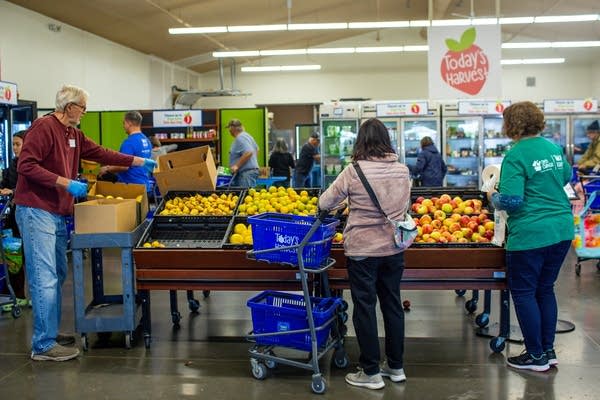Minnesota sees historic levels of hunger ahead of holiday season

Go Deeper.
Create an account or log in to save stories.
Like this?
Thanks for liking this story! We have added it to a list of your favorite stories.
On the Friday before Thanksgiving, there was a steady stream of people waiting in line to pick out fresh produce inside Open Cupboard’s small free market in Oakdale.
Executive director Jessica Francis pointed out the restaurant-style pagers the customers at the free market, called Today’s Harvest, held on to as a way to manage the influx of people. On this day alone, Francis said she expected they would serve 1,000 families.
“Thanksgiving is always a really busy time,” Francis explained. “People who might not need help from us all the time need help right now.”

Francis said the need in her community, which serves about a 100-mile radius, has only continued to grow since the height of the pandemic and the drying up of many pandemic-related safety nets.
Turn Up Your Support
MPR News helps you turn down the noise and build shared understanding. Turn up your support for this public resource and keep trusted journalism accessible to all.
“We’re expecting to have our busiest holiday season ever,” Francis said.
It is unclear if this unprecedented level of hunger will become the new normal in Minnesota. Minnesotans made 5,505,100 visits to food shelves in 2022, a record high, and nearly 2 million more than 2021, according to Hunger Solutions Minnesota. This year, the number may top 7 million.

On Monday, the state allocated $5 million in federal pandemic relief funds toward food shelves across the state to help them purchase more food to address the unprecedented need. But until the cost of living decreases and wages increase, Francis said it will take the effort of entire communities to make sure everyone can make ends meet.
Volunteers Larry and Teri Doran, a retired couple from Woodbury in their 60s, say they have noticed more people pouring in, especially older people, over the one year they have been helping stock shelves on most mornings. Larry Doran says everyone is feeling the pinch of inflation.
“All of a sudden you have eggs that are $5 a dozen and that kind of thing,” Larry Doran said.

Today’s Harvest market resembles a grocery store. Everyone gets a cart, and they ring up their food at registers. But only in order for the non-profit to keep track of its inventory.
Anyone who comes in is welcome to get what they need for free, Francis said. They must only share their zip code and how many seniors, adults and children are in their homes.
“We work really hard to try to make it feel as much like a grocery store experience as you can within a nonprofit budget,” she said.

There is also a drive up service in the back of the warehouse with a long line of cars rolling through.
Volunteers load pre-made boxes filled with a range of essentials, from non-perishables, to milk and diapers. All of the donated items are from area grocery stores that would otherwise go to waste.
Open Cupboard served 5 million pounds of food last year and expects to serve closer to 6 million this year. The most ever served in its 40-year history.

The unprecedented need is both unsustainable and across the board, according to Keystone Community Services Program Director Julia McCarthy.
Keystone has two St. Paul food shelf locations and serves about 40,000 people per year, mostly in Ramsey County, in areas where McCarthy says the rate of food insecurity is around 25 percent.
“It’s a problem that isn't always visible to people,” McCarthy explains. “A lot of our participants have jobs, they have homes, but just the cost of living is more than they can keep up with.”

Keystone is moving into another location in January with a warehouse to store more items, but there are times when they cannot serve everyone they need to in a day.
McCarthy said there is always a need for more volunteers and donations at all food shelves, especially monetary donations, which they are able to stretch further since they buy goods at discounted prices.
According to Hunger Solutions Minnesota, last year, communities just east and north of the Twin Cities including Washington, Anoka, Sherburne Counties and in north central Minnesota, including Itasca and Beltrami Counties saw the greatest increase in food shelf visits from the previous year.
Many of the people visiting food shelves right now are doing so for the first time.


